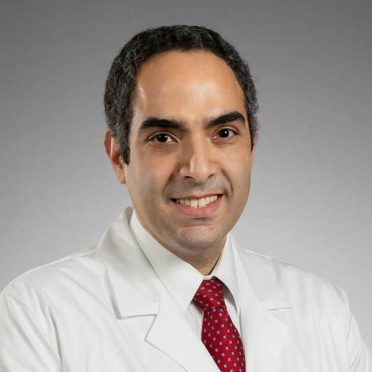Alyssa Madera was eating a meal about a year and a half ago when suddenly it felt like her food was stuck in the middle of her throat. It wouldn’t go down, no matter how hard she tried swallowing. Instead, it came back up.
The problem was happening randomly, she said. Then it started happening all the time. No matter what she ate, how much she chewed it, the food would stick in her esophagus until she vomited. She lost a dramatic amount of weight over a few months. The then-23-year-old had only about 95 pounds on her 5-foot, 9-inch frame.
“I kept thinking it would go away, but it didn’t,” she said.
> Concerned about swallowing or acid reflux? Connect with an expert today
It turned out Alyssa had dysphagia, a condition in which a person has difficulty swallowing food or liquid. It can be painful, and in severe cases, swallowing becomes impossible. Because swallowing involves many muscles and nerves, any condition that weakens or damages those muscles and nerves can cause dysphagia. It is more common in older adults.
Because Alyssa was so much younger than the typical dysphagia patient, there was initial concern that she had a rare and serious condition called achalasia, which is caused when the nerves and muscles in the esophagus are damaged, said Amir E. Masoud, MD, medical co-director of the Hartford HealthCare Neurogastroenterology and Motility Center.
An upper endoscopy using technology called EndoFLIP showed that in fact, she had a narrowing of her upper esophagus that was so subtle a regular endoscopy would not have shown it. Dr. Masoud was instrumental in bringing the EndoFlip technology to Connecticut, and is one of the few providers in the state with expertise in using it.
Once it was diagnosed, Dr. Masoud performed a bougie dilation to widen the affected portion of her esophagus, using a thin plastic tube called a bougie along with an endoscope to widen your esophagus.
Done under anesthesia, Alyssa said her throat was a little sore right after the procedure, but otherwise she had no ill effects. “I had a burger right after my procedure.”
She’s now back to her normal weight. “Dr. Masoud is a great doctor,” she said. “He definitely makes you feel comfortable. He explains everything for you to understand.”
> Want more health news? Text StartHere to 85209 to sign up for text alerts
What to watch for
Signs and symptoms associated with dysphagia can include:
- Pain while swallowing
- Inability to swallow
- A sensation of food getting stuck in the throat
- Drooling
- Hoarseness
- Regurgitation
- Frequent heartburn
- Food or stomach acid backing up into the throat
- Weight loss
- Coughing or gagging when swallowing
Common offenders
Dysphagia generally falls into one of the following categories:
- Esophageal dysphagia. This involves the sensation of food sticking or getting caught in the base of your throat or in your chest after you’ve started to swallow.
- Oropharyngeal dysphagia. Certain conditions can weaken the throat muscles, making it difficult to move food from your mouth into your throat and esophagus when you start to swallow. You might choke, gag or cough when you try to swallow.
Down the road
Dysphagia can lead to:
- Malnutrition, weight loss and dehydration.
- Aspiration pneumonia. Food or liquid entering the airway during attempts to swallow can cause aspiration pneumonia as a result of the food introducing bacteria into the lungs.
- Choking. If food completely blocks the airway and there is no successful Heimlich maneuver, it can be fatal.
Diagnosis
To diagnose dysphagia, options include:
- X-ray with a contrast material (barium X-ray). A barium solution makes it easier to see your esophagus on X-rays.
- Dynamic swallowing study. In this test, you swallow barium-coated foods of different consistencies and images are taken as you swallow.
- Endoscopy. This is a visual examination of your esophagus in which a thin, flexible lighted instrument (endoscope) is passed down your throat.
- Fiber-optic endoscopic evaluation of swallowing (FEES). This also involves an endoscopy.
- Esophageal muscle test (manometry). A small tube is inserted into your esophagus and connected to a pressure recorder to measure the muscle contractions of your esophagus as you swallow.
- CT or MRI imaging scan.
Treatment
Treatment options depend on the type or cause:
For oropharyngeal dysphagia, a speech or swallowing therapist might be utilized. Therapy might include:
- Exercises. Certain exercises might help coordinate your swallowing muscles or restimulate the nerves that trigger the swallowing reflex.
- Swallowing techniques. You might also learn ways to place food in your mouth or position your body and head to help you swallow. Exercises and new swallowing techniques might help if your dysphagia is caused by neurological problems such as Alzheimer’s or Parkinson’s disease.
Treatment approaches for esophageal dysphagia might include:
- Esophageal dilation. Here, an endoscope with a special balloon attached is used to gently expand your esophagus.
- Surgery. For an esophageal tumor, achalasia or pharyngoesophageal diverticulum, you might need surgery.
- Medications. Difficulty swallowing associated with GERD can be treated with prescription oral medications to reduce stomach acid.
- Diet. A special diet might help with your symptoms. If you have eosinophilic esophagitis, diet might be used as treatment.



